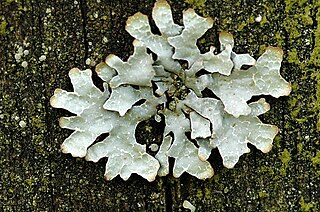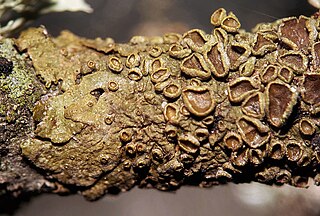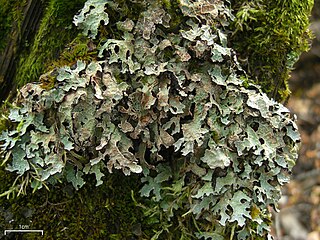
Parmelia is a genus of medium to large foliose (leafy) lichens. It has a global distribution, extending from the Arctic to the Antarctic continent but concentrated in temperate regions. There are about 40 species in Parmelia. In recent decades, the once large genus Parmelia has been divided into a number of smaller genera according to thallus morphology and phylogenetic relatedness.

Parmelia sulcata, commonly known as the hammered shield lichen or cracked-shield lichen, is a foliose lichen in the family Parmeliaceae. First described by Thomas Taylor in 1836, it is one of the most prevalent lichen species globally, known for its resilience to pollution and cosmopolitan distribution across temperate and cold regions of both hemispheres. P. sulcata forms a circular thallus up to 10 cm (4 in) in diameter, with a glaucous white to grey upper surface and a black lower surface, featuring broadly lobed structures with both marginal and laminal soralia and a distinctive reticulate pattern of pseudocyphellae.

Melanohalea is a genus of foliose lichens in the family Parmeliaceae. It contains 30 mostly Northern Hemisphere species that grow on bark or on wood. The genus is characterised by the presence of pseudocyphellae, usually on warts or on the tips of isidia, a non-pored epicortex and a medulla containing depsidones or lacking secondary metabolites. Melanohalea was circumscribed in 2004 as a segregate of the morphologically similar genus Melanelia, which was created in 1978 for certain brown Parmelia species. The methods used to estimate the evolutionary history of Melanohalea suggest that its diversification primarily occurred during the Miocene and Pliocene epochs.

Melanelixia is a genus of foliose lichens in the family Parmeliaceae. It contains 15 Northern Hemisphere species that grow on bark or on wood. The genus is characterized by a pored or fenestrate epicortex, and the production of lecanoric acid as the primary chemical constituent of the medulla. Melanelixia was circumscribed in 2004 as a segregate of the related genus Melanelia.

Parmotrema is a genus of lichen belonging to the family Parmeliaceae. It is a large genus, containing an estimated 300 species, with a centre of diversity in subtropical regions of South America and the Pacific Islands.
Parmelia asiatica is a species of corticolous (bark-dwelling) foliose lichen in the family Parmeliaceae. It was described as new to science in 2011 by lichenologists Ana Crespo and Pradeep Divakar, based on specimens from Yunnan, China. Since then, its known distribution has expanded to include various regions of Russia, parts of North America, and as of 2024, European Russia. The species is found in the forests of temperate and boreal climates, growing on the bark of various tree species. Parmelia asiatica is distinguished by its small thallus with narrow, more or less linear lobes, soralia that appear at the ends of the lobes, marginal linear pseudocyphellae, and a chemical composition that includes atranorin, salazinic acid, and consalazinic acid. While similar to other Parmelia species, it can be differentiated from them by its morphological and chemical characteristics.
Emodomelanelia is a lichen genus in the family Parmeliaceae. It is monotypic, containing the single foliose Himalayan species Emodomelanelia masonii.
Austromelanelixia is a genus of five species of foliose lichens in the family Parmeliaceae. All species are found in the Southern Hemisphere.
Melanohalea ushuaiensis is a species of lichen in the family Parmeliaceae. It was first formally described in 1917 by Alexander Zahlbruckner as Parmelia ushuaiensis. Ted Esslinger transferred to the new genus Melanelia in 1978, which he circumscribed to contain the brown parmeliae species. In 2004, it was moved to the newly created genus Melanohalea. It is endemic to South America.
Melanohalea trabeculata is a species of foliose lichen in the family Parmeliaceae. It was first formally described by Finnish lichenologist Teuvo Ahti in 1966 as Parmelia trabeculata. Ted Esslinger transferred the species to the new genus Melanelia in 1978, which he circumscribed to contain the brown parmeliae species. In 2004, it was moved to the newly circumscribed genus Melanohalea.
Melanohalea subverruculifera is a species of lichen in the family Parmeliaceae. Found in China, it was first formally described as a new species in 1980 as Parmelia subverruculifera. It was transferred to the segregate genus Melanelia in 1991, and then to the genus Melanohalea in 2004.

Melanohalea subolivacea, commonly known as the brown-eyed camouflage lichen, is a species of foliose lichen in the family Parmeliaceae.

Melanohalea subelegantula is a species of lichen in the family Parmeliaceae. It is found in North America, where it grows on bark and wood. The lichen was first formally described as Parmelia subelegantula by Ted Esslinger in 1977. A year later he transferred it to the segregate genus Melanelia. In 2004, it was moved to the newly circumscribed genus Melanohalea. Named for its resemblance to Melanohalea elegantula, it can be distinguished from that species by its slightly flattened, but not hollow, isidia.

Melanohalea elegantula, commonly known as the elegant camouflage lichen, is a species of lichen in the family Parmeliaceae. It was first described by Alexander Zahlbruckner in 1894 as Parmelia aspidota var. elegantula. Hungarian lichenologist Ödön Szatala promoted it to full species status, as Parmelia elegantula, in 1930. Ted Esslinger transferred it to the genus Melanelia in 1978. Finally, it was assigned to the newly circumscribed genus Melanohalea in 2004.
Pleurosticta koflerae is a species of foliose lichen in the family Parmeliaceae. It is a member of the group of species informally known as the "brown Parmeliae". The lichen was first formally described as Parmelia koflerae by lichenologists Georges Clauzade and Josef Poelt in 1961. Theodore Esslinger transferred it to the genus Melanelia in 1978 when he reorganized the classification of the brown Parmeliae, a continuation of his research on the group published the year before. It was finally transferred to the newly resurrected genus Pleurosticta in 1988 by H. Thorsten Lumbsch and John A. Elix.

Parmelia barrenoae is a species of foliose lichen in the large family Parmeliaceae. It was formally described as a new species in 2005. Before this, it was lumped together as one of several lichens in the Parmelia sulcata group—a species complex of genetically distinct lookalikes. Parmelia barrenoae is widely distributed, occurring in Europe, western North America, Africa, and Asia.

Parmelia fraudans is a species of foliose lichen in the family Parmeliaceae. It is found in Europe and North America, where it grows on rocks.
Melanelixia ahtii is a species of foliose lichen in the family Parmeliaceae. Found in the United States, it was formally described as a new species in 2016 by Theodore Lee Esslinger, Ana Crespo, Helge Thorsten Lumbsch, Pradeep Kumar Divakar, and Steven Leavitt. The type specimen was collected from the north side of the Columbia River Gorge. Here, at an elevation of 75 m (246 ft) above sea level, it was found in a mixed oak-ponderosa pine forest, growing as an epiphyte on an oak. The species is known from DNA-verified collections in four western US states: California, Idaho, Oregon, and Washington. The species epithet ahtii honours Finnish lichenologist Teuvo Ahti, "for his contributions to understanding diversity in brown parmelioid lichens".

Melanelia hepatizon, commonly known as the rimmed camouflage lichen or the rimmed brown-shield, is a species of saxicolous (rock-dwelling), foliose lichen in the family Parmeliaceae. Its thallus, ranging in colour from brown to black, features narrow, elongated lobes that can be flat, convex, or concave. This lichen has a circumpolar distribution, occurring in Asia, Europe, North America, Iceland, and Greenland.

Melanohalea exasperatula, commonly known as the lustrous camouflage lichen or lustrous brown-shield, is a species of corticolous (bark-dwelling) foliose lichen in the family Parmeliaceae. It has a widespread global distribution and is common in both Europe and northern North America. Its thallus can grow up to 5 cm (2 in) in diameter, with marginal lobes up to 5 mm broad. The upper surface is pale olive-green to red-brown, with isidia that are unbranched, inflated, and hollow. It can be distinguished from similar species by the shape and structure of these isidia. The lower surface of the thallus is pale tan to pale brown with scattered, pale rhizines. Apothecia are uncommon, while pycnidia and secondary metabolites have not been observed in this species. The lack of defensive chemicals makes it vulnerable to grazing by slugs and snails. The evolutionary history of Melanohalea exasperatula is linked to major climatic events during the Miocene and Pliocene epochs.













